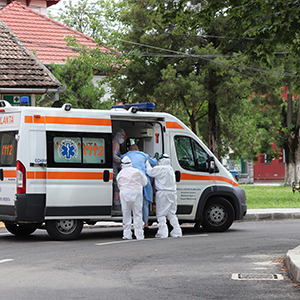Usefulness of CURB-65, pneumonia severity index and MuLBSTA in predicting COVID-19 mortality

Submitted: August 17, 2021
Accepted: February 14, 2022
Published: February 22, 2022
Accepted: February 14, 2022
Abstract Views: 1790
PDF: 572
Supplementary: 204
Supplementary: 204
Publisher's note
All claims expressed in this article are solely those of the authors and do not necessarily represent those of their affiliated organizations, or those of the publisher, the editors and the reviewers. Any product that may be evaluated in this article or claim that may be made by its manufacturer is not guaranteed or endorsed by the publisher.
All claims expressed in this article are solely those of the authors and do not necessarily represent those of their affiliated organizations, or those of the publisher, the editors and the reviewers. Any product that may be evaluated in this article or claim that may be made by its manufacturer is not guaranteed or endorsed by the publisher.
Similar Articles
- Iffat Khanum, Fatima Samar, Yousuf Fatimah, Awan Safia, Aziz Adil, Habib Kiren, Nasir Nosheen, Mahmood Faisal, Jamil Bushra, Role of awake prone positioning in patients with moderate-to-severe COVID-19: an experience from a developing country , Monaldi Archives for Chest Disease: Vol. 91 No. 2 (2021)
- Halil Yanardag, Cuneyt Tetikkurt, Muammer Bilir, Carpal tunnel syndrome associated with sarcoidosis in identical twin patients , Monaldi Archives for Chest Disease: Vol. 89 No. 3 (2019)
- Massimiliano Polastri, Stefano Nava, Pulmonary Rehabilitation , Monaldi Archives for Chest Disease: Vol. 90 No. 3 (2020)
- Elena Bargagli, Viola Bonti, Alessandra Bindi, Vieri Scotti, Massimo Pistolesi, Luca Voltolini, Katia Ferrari, Fibrotic lung toxicity induced by cytotoxic drugs, radiation and immunotherapy in patients treated for lung cancer , Monaldi Archives for Chest Disease: Vol. 88 No. 2 (2018)
- Nitesh Gupta, Pranav Ish, Rohit Kumar, Nishanth Dev, Siddharth Raj Yadav, Nipun Malhotra, Sumita Agrawal, Rajni Gaind, Harish Sachdeva, *Other members of the Safdarjung Hospital COVID 2019 working group, Evaluation of the clinical profile, laboratory parameters and outcome of two hundred COVID-19 patients from a tertiary centre in India , Monaldi Archives for Chest Disease: Vol. 90 No. 4 (2020)
- Pierluigi Carratù, Roberto Boffi, Silvano Dragonieri, Elena Munarini, Chiara Veronese, Piero Portincasa, Covid-19 and ex-smokers: an underestimated prognostic factor? , Monaldi Archives for Chest Disease: Vol. 90 No. 3 (2020)
- Silvia Porcu, Antonella Mandas, How to evaluate Quality of Life , Monaldi Archives for Chest Disease: Vol. 89 No. 1 (2019)
- Daniel Samolski, Roberto Duré, Gonzalo Bentolila, Teresa Castiglioni , Metastatic pulmonary calcification diagnosed by transbronchial cryobiopsy , Monaldi Archives for Chest Disease: Vol. 90 No. 4 (2020)
- Nitesh Gupta, Sumita Agrawal, Pranav Ish, Suruchi Mishra, Rajni Gaind, Ganapathy Usha, Balvinder Singh, Manas Kamal Sen, *Safdarjung Hospital COVID 2019 working group, Clinical and epidemiologic profile of the initial COVID-19 patients at a tertiary care centre in India , Monaldi Archives for Chest Disease: Vol. 90 No. 1 (2020)
- Alessandro Matarese, Mario Tamburrini, Unnati Desai, Umberto Zuccon, Percutaneous lung abscess drainage: revisiting the old gold standard , Monaldi Archives for Chest Disease: Vol. 90 No. 1 (2020)
<< < 60 61 62 63 64 65 66 67 68 69 > >>
You may also start an advanced similarity search for this article.

 https://doi.org/10.4081/monaldi.2022.2054
https://doi.org/10.4081/monaldi.2022.2054





